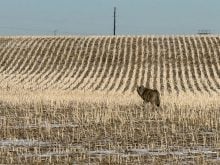A recent conference on dairy industry sustainability and environmental impact produced unlikely role models for the Canadian dairy industry.
The Alberta government, usually reviled by environmentalists for its support of the oilsands, was lauded as a governmental model for creating North America’s first cap-and-trade system that values carbon at $15 per tonne.
The retail giant Walmart, often viewed suspiciously by farmers as a discount seller with enough clout to reduce farmgate food prices, was praised for a commitment to reduce greenhouse gas emissions and force its suppliers to meet its green standards.
Read Also

Agritechnica Day 3: Hybrid drive for a combine, data standards keep up to tech change and tractors of the year
Agritechnica 2025 Day 3: Hybrid drive for a combine, data standards keep up to tech change and tractors of the year.
And the U.S. dairy industry unveiled its own plan to reduce greenhouse gas emissions that had dairy industry leaders at the Ottawa conference wondering how they can catch up.
A key issue of discussion during the recent two-day conference was that farmers need an economic or business incentive to take measures that reduce their greenhouse gas emissions.
Many focused on Alberta’s carbon market that pays provincial businesses $15 per tonne for carbon-equivalent reductions, making those credits available to businesses that exceed emission caps.
“We need an incentive system and that is a carbon credit system,” Dairy Farmers of Canada president Jacques Laforge told the conference.
He urged delegates to pressure their provincial governments to create a carbon market similar to Alberta’s, although the preferred route would be a Canadian or North American carbon market so the rules are the same for everyone.
During the conference, American Dairy Association official Rich Naczi outlined an American industry plan to reduce greenhouse gas emissions in the fluid milk system by 25 percent in the next decade.
He said the plan ranges from increased feed efficiencies to designing a more efficient cow.
The goal is to reduce carbon dioxide equivalent emissions by 3.2 million tonnes by 2020 while creating $238 million in new revenue to the American dairy industry.
“We have been cutting emissions and I don’t think we have a lot to apologize for,” Naczi said.
“But we have a plan and industry co-operation and we believe it is better to be proactive than to be dragged into it by consumers or regulation.”
He said it is a voluntary plan that industry executives have designed and embraced.
It also was driven in part by Walmart, which launched an aggressive plan to reduce greenhouse gas emissions from its supplier and retail chain by millions of tonnes.
The company will also have an impact in Canada as it expands its food retail business.
Dairy Processors Association of Canada president Don Jarvis said the Walmart website features case studies of 70 suppliers that comply with company green rules.
Several Canadian dairy processors talked about efforts their companies have made in recent years to become more environmentally benign.
The consistent message was that Canadians on the ground are ahead of a cautious federal government that is waiting for the United States to lead and trying to balance greenhouse gas reduction goals with the pollution reality of the prairie energy sector.
Senior Agriculture Canada environmental official Marie Boehm was asked about the perception that the Canadian government is a climate change laggard.
“In a sense, government policy might be seen as slow moving but production practices are not,” she said, referring to the agriculture sector.














